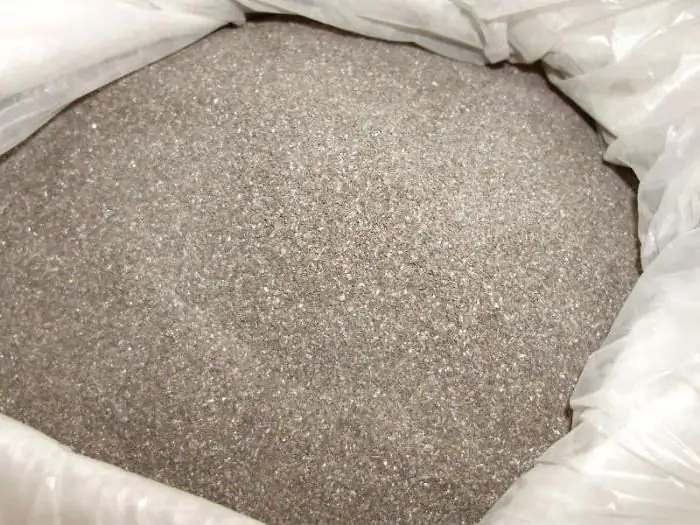2026 Author: Howard Calhoun | [email protected]. Last modified: 2025-01-24 13:10:37
Today, there are rough diamonds that comply with the regulatory document TU 47-2-73. However, diamond powders that are manufactured in accordance with GOST 9206-80E are used more actively, since they can be obtained from synthetic types of diamonds, and not only from natural ones.
Powder description
There is another abrasive, that is, non-diamond rough, which is also used, but it is inferior in such quality as hardness. The requirements for diamond powder are also much higher, especially for grain size and strength.
There is a main parameter by which the further scope is determined. This parameter is the brand of diamond and, accordingly, the brand of powder obtained from it. In addition, an important role is played by such an indicator as the grain size of the diamond powder and the concentration of this raw material in the cutting layer of the tool. It is worth noting that, in essence, each diamond grain is a working cutting edge of a tool. For this reason, each grain must provide maximum efficiency duringoperating time at any tool position.

GOST powder grades
As mentioned earlier, GOST diamond powder 9206-80E is a document that determines the quality indicators of raw materials. It also has a division of the substance into certain brands.
In this case, we are talking about the classification of powder, which can only be obtained from natural diamond. There are 5 brands in total, and the main difference between them is the content of strong grains with an isometric shape. The powder is marked as A1, A2, A3, A5 and A8. The number that comes after the letter A indicates the number of isometric grains in the diamond powder in tens of percent. In other words, for example, A3 will contain 30% isometric diamond grains. There is also a category that is distinguished as micropowders. They can also be obtained only from natural diamonds, and they are divided into two categories - AM and AN. AM is a group of powders in which the abrasive ability is at a normal level, AN are substances in which this level is considered elevated.

Synthetics
As for synthetic diamonds, the powders obtained from them also have a classification, and they also differ in their performance and physico-chemical properties. For them, the same GOST is used as for natural ones. According to this regulatory document, synthetic powders are divided into two groups:
- the first group is a powder obtained fromsingle-crystal diamonds and marked AC2, AC4, AC6, AC15, AC20, AC32, AC50;
- second group - powder obtained from polycrystalline diamonds grades APBI, ARK4, ARSZ.
Here it is worth adding that recently for the manufacture of tools used in industry for machining, especially strong synthetic single crystals are used. They make powder, which is labeled as AC65, AC80 and AC80T.

Description of stamps
Diamond powder, which is labeled as AC2, may also sometimes be called ASO. The peculiarity of the raw material is that the grains are mainly presented as aggregates with a developed surface. They exhibit increased brittleness and their primary use is in organic bonds in tools used to polish stone.
The powder of the next brand, that is, AC4 or ACP, consists not only of aggregates, but also of intergrowths, and they are used for tools used for finishing polishing of stone.
AC6 powder or ASV is already a more durable category, since grains are presented in the form of imperfect crystals, their intergrowths and fragments. Due to their high strength, they are already used on metal bindings of stone processing tools.

Diamond powder AC15 or ASA is represented by high-strength grains in the form of solid crystals, their fragments and intergrowths with a grain ratio of not more than 1.6. As for solid crystals, they have a smalla flaw that lies in an imperfect form. This powder is heavily used on metal bonded tools, which are intended for grinding medium hard stone.
Next comes the AC20 brand. The powder in this case consists of the same crystals, fragments and intergrowths as AC15, with only one difference - the grain shape coefficient is not more than 1.5. Scope - tools for grinding stone. AC32 is a raw material that is already presented in the form of well-faceted grains of crystals, their fragments. The main difference is the increased strength factor, as well as the coefficient of the grain itself, not more than 1, 2.
The most valuable brand is AC50. Also, the powder is presented in the form of whole, well-cut grains of crystals and their fragments, but the shape factor is even higher and is no more than 1.18. It is used for tools designed for milling and edging the most durable stone.
Polycrystal powder
It is worth noting that the use of polycrystals to obtain a powder is also considered quite promising. By themselves, polycrystals are conglomerates of small, intergrown diamonds, bound by a charge material used in their synthesis. Such binding elements can be iron, nickel, chromium and other elements. Three main categories of polycrystalline powder grades were previously indicated, however, only two of them are used to create tools - these are APC4 and APC3.

Diamond drilling
This operation is consideredthe most efficient and fastest, if you need to get an even cylindrical hole in a sufficiently strong material. The main difference between the use of a diamond tool and a jackhammer or perforator is that the hole is not only perfectly even, but also without the slightest cracks. In addition, the diamond drilling process is very quiet and requires almost no effort. The machine that is used for this type of work does not have an impact mechanism, and the hole is cut using a cutting tool that is made of rough diamonds. It is thanks to this that you can get a perfectly even hole in any material, at any angle and almost any depth.
Recommended:
Modern production. The structure of modern production. Problems of modern production

Developed industry and a high level of the country's economy are key factors influencing the we alth and well-being of its population. Such a state has great economic opportunities and potential. A significant component of the economy of many countries is the production
Gas production. Gas production methods. Gas production in Russia

Natural gas is formed by mixing various gases in the earth's crust. In most cases, the depth of occurrence ranges from several hundred meters to a couple of kilometers. It is worth noting that gas can form at high temperatures and pressures. In this case, there is no access of oxygen to the place. To date, gas production has been implemented in several ways, each of which we will consider in this article. But let's talk about everything in order
Abrasive powder: production, consumption. Where can abrasive powder be used?

Abrasive powder is mainly used to clean metal surfaces from rust. Most often, for this purpose, its varieties such as cooper slag and nickel slag are used. Diamond powder is used to make abrasive pastes and grinding tools
Copper powder: production, purpose and application

Copper powder is a product widely used in the paint and varnish, chemical, automotive, instrument making, and nanotechnologies industries. There are several main brands of such a product. And all of them are produced in accordance with the standards stipulated by GOST
Artificial diamond: name, production

Diamonds have attracted mankind since ancient times. The extraordinary beauty of these stones has led to their use to create various jewelry. However, later people discovered other useful properties of diamonds - their unique strength and hardness. To meet the needs of production, nature did not create much of this material, so people had the idea to make diamonds artificially

